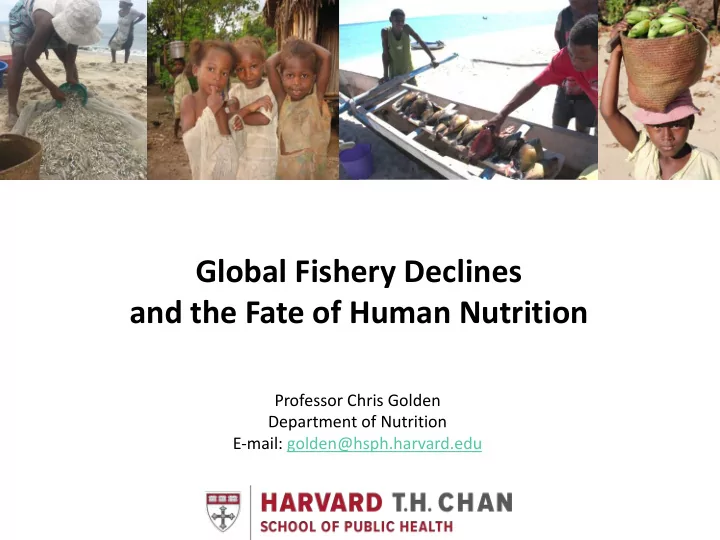

Global Fishery Declines and the Fate of Human Nutrition Professor Chris Golden Department of Nutrition E-mail: golden@hsph.harvard.edu
Environmental Change as Public Health Risk • Body 1 – Body 2 • Body 3
The Importance of Animal Source Foods
Fish Catch Declines and Micronutrient Nutrition Environmental Change • Fish population declines Changes in • Reduced access to animal-source foods Food Supply Changes in • Micronutrient and vitamin intake decreases Nutrient Intake • Increased incidence of micronutrient Health Impacts deficiencies and NCDs
THETIS: Tracking Health and Ecosystem Transformation in the Seas Planetary Health Ecosystem Nutritional Epidemiology Human Complex (PI) Services Geography Systems Climate Ocean Fisheries Catch Fisheries Fisheries Impacts Health Ecology Histories Economics Governance
Declining Fish Catch Aquaculture/Fisheries Alternative Foods Management Nutritional Vulnerability Dietary Change
Declining Fish Catch Aquaculture/Fisheries Alternative Foods Management Nutritional Vulnerability Dietary Change
CHANGE IN MAXIMUM FISH CATCH POTENTIAL 2041-2060 relative to 1981 – 2000 <50% -51 – -30% -31 – 10% -10 – 6% -5 - -1% 0 – 4% 5 – 19% 20 – 49% 50 – 100% >100% Cheung et al . update of IPCC (2014) AR5 WGII
Declining Fish Catch Alternative Aquaculture/Fisheries Foods Management Nutritional Vulnerability Dietary Change
Declining Fish Catch Aquaculture/Fisheries Alternative Foods Management Dietary Nutritional Change Vulnerability
Three Typologies Unaffected wealthy nations Increasing undernutrition Acceleration of nutrition transition
Declining Fish Catch Aquaculture/Fisheries Alternative Foods Management Nutritional Vulnerability Dietary Change
Declining Fish Catch Aquaculture/ Fisheries Alternative Foods Management Nutritional Vulnerability Dietary Change
Fisheries Management and Marine Conservation as a Nutritional Intervention Fisheries Management and Marine Conservation as a Nutritional Intervention Costello et al. 2016
Increasing Fish Catch Aquaculture/Fisheries Strengthening Management Resilient Food Systems Nutritional Security Positive Dietary Change
An Environment of Chronic Undernutrition 70% Stunting prevalence 60% 50% 40% (%) 30% 20% 10% 0% i e l a r r a a d e a t l i a n p d s c g u e m n e i s N r L a N I e u - g t B r a a o d u m a G i M T
Global Prevalence of Anemia
Double-click to enter title
Overall Diet by Weight Bushmeat, insects, Fruits and Misc, 3.89% wild birds, 4.57% nuts, 3.51% Poultry and Beef and pork, eggs, 1.09% 1.61% Vegetables, Seafood and greens, and freshwater fish (fresh palm hearts, and dried), 1.33% 10.25% Beverages, 0.02% Staples and bananas, 15.92% Rice, 57.81%
Animal Source Foods Beef and pork, 18.70% Poultry and eggs, 12.62% Bushmeat, insects, wild birds, 53.16% Seafood and freshwater fish (fresh and dried), 15.52% Some are eating 70kg of wildlife in a year, the equivalent of a single household receiving 12 quarter-pounder burgers per week from the forest
Median household sufficiency (% EAR) 100 150 200 250 50 0 vitamin D vitamin B12 calcium vitamin A vitamin E riboflavin (B2) sodium kilocalories folate (B9) vitamin C thiamin (B1) zinc protein iron niacin (B3) vitamin B6 phosphorus magnesium copper carbohydrates Adequate Deficient Deficient Severely
Study Design Maroantsetra Prospective cohort study, n=1009; 3 years from 2014- 2017 High frequency diet, health, 4 and economic data 3 Weekly fish catch data 2 1 5 Management systems: Locally managed marine area (LMMA) 1 2 Traditionally managed area 3 4 Antongil Bay Marine National Park (MNP) 5
Interactive Dynamics of Reef Fisheries and Human Health in Kiribati Kiribati
Nutrition Transitions
Health assessment Fingerstick of blood (Point of Care) • Metabolic disease markers (total cholesterol, HDL and LDL, triglycerides, and glucose) • Hemoglobin A1c (diabetes) • Hemoglobin (anemia) • Fatty acid profiles of 23 different fatty acids incl. DHA & EPA Anthropometry and Diagnostics • Blood pressure • Standard anthropometry (height/length, weight) • Abdominal circumference
Pathways and international collaborators Pathways and international collaborators Kiribati Ministry of UC Health and Medical Santa Cruz Sciences
Acknowledgments • Bapu Vaitla, Andy Kim, and Eddie Allison • Katy Seto, Jessica Gephart, Jacob Eurich, Doug McCauley • Mike Sharp and the Secretariat of the Pacific • Neil Andrew and the Pathways program
Recommend
More recommend